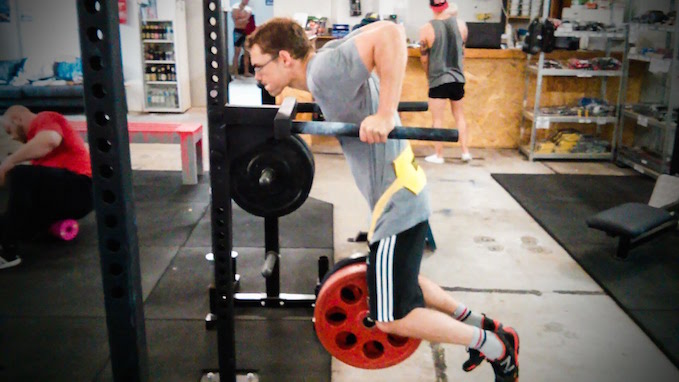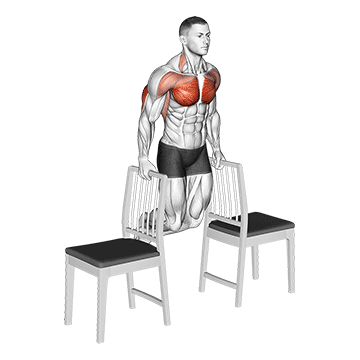What are chest dips?
Chest dips are commonly talked about in the gym, on bodybuilding forums and in magazines by bodybuilders but, if you are new to the gym scene, you may not know what chest dips are. You may have performed tricep dips and wonder how they differ.
Chest dips are a resistance exercise performed on dip bars or rings. The exercise targets the pectoral muscles in the chest as well as the triceps and anterior deltoids. The resistance used can just be bodyweight or weight plates attached to a belt. Dips are a popular upper body exercise for bodybuilders as they really activate the lower part of the pecs that do not get worked as hard with a traditional bench press.
Which muscles are targeted with dips?
The main target muscle with dips is the pectoral muscles in the chest. Triceps are also heavily worked with the pressing movement making this a great compound upper body exercise. Shoulders and core muscles are responsible for stabilising the body and keeping a rigid posture.
The majority of bodybuilders will use dips as a finisher to a chest routine but it arguably has its place as a 'stand alone' exercise in your split. The only other exercise that targets the lower section of the pectoral muscle with as much effect as a dip is a decline bench press. For a full and well-defined chest, dips should be a regular staple in your exercise routine.
How do I perform dips?
The easiest way to perform dips is on dip bars. Make sure that the bars allow a wide grip otherwise your triceps will be doing all of the work. Most gyms will have dip bars, a dip station or a dip machine.
This article will detail the different types of dip options available as well as alternatives and tips.
Traditional dips
Tradition chest dips are performed on dip bars or a dip station. You must understand how dips work, which muscles you are targeting and how to perform the movement correctly.
An incorrect grip, stance or movement can take resistance away from the pectoral muscles and place heavy reliance on the triceps and shoulders.
- Approach your dip station or dip bars. Make sure that they are on the outer setting so that your grip is slightly wider than shoulder-width.
- This movement can be performed either facing the station or facing outwards. As long as you have room behind you to flex your elbows and tilt forward.
- Step up onto the platform and grip the handles with an overhand grip.
- Let your arms take your weight and tilt forward to around 45 degrees.
- Lower your body downwards and forwards by flexing the elbows behind you.
- Keep lowering the body until your head dips lower than your elbows and you feel the stretch in your chest. This is your starting position.
- Whilst keeping in the tilted position, press yourself upwards until your arms are almost fully extended.
- Avoid locking out your arms so that your chest remains under tension throughout the entire set.
- Slowly return to the start position and repeat for the required number of reps and sets.
Tips
Once you are in the start position, take a deep breath in and press upwards upon exhale. Make sure you keep breathing throughout the movement by inhaling on the negative movement and exhaling on the pressing movement.
Focusing on an explosive press and a slow, controlled negative movement will target both the slow-twitch and fast-twitch muscles within the chest and triceps. Breaking down both of these fibres will lead to bigger gains when the muscles repair.
Weighted dips.
Weighted dips are performed in exactly the same way as standard dips. The only difference is the extra resistance. Weighted dips should only be performed if you find standard dips too easy.
Most beginner and intermediate trainers will stick with bodyweight dips or even assisted dips but if you want to take it to the next level, strap on a belt.

If you do not have a dip belt available, there are other ways of adding extra resistance to your dips. You can use a weighted vest, grip a dumbbell between your thighs if you are not going too heavy or, if you have them, put weighted chains around your neck.
Most advanced trainers will opt for the weighted chains as they can quickly strip them off for drop sets and, they make for a great Instagram photo!
Assisted dips
Assisted dips are great if you are new to training or have never performed dips before. By adding a counterweight to your dip, you can develop the muscles and get to a point where you can perform the movement unassisted. To perform assisted dips, you will need an assisted dip machine.
- Approach the machine, select your desired counterweight from the stack and turn the handles to the outer position (if they are adjustable).
- Fold down the knee pad and climb onto the machine. Grip the bars with your hands and allow your arms to take the strain.
- Lean forward as you would with a traditional chest dip.
- Whilst keeping a straight back, flex your elbows behind you and bend your arms.
- Once your elbows are level or above your head behind you, you are in the starting position.
- Take a deep breath, upon exhale, extend the arms and push yourself upwards.
- Make sure that you can feel a connection with the pectoral muscle. Stop pressing before your arm is straight. Keeping the arm slightly bent at the top of the movement will keep constant tension on the muscle.
- Slowly lower yourself back into the start position and repeat for the required number of reps and sets.
Take each set to failure and try to lower the counterweight slightly each week until you can perform the movement without assistance.
Chest dip variations.
There are numerous other ways of performing dips but the above are the most effective. If you are an advanced trainer, you can consider using gymnastic rings.
Performing dips on gymnastic rings is incredibly hard as you have to focus on not allowing your arms to flare out at the same time as pressing your bodyweight. Once mastered, they are a fantastic upper body compound movement.
You can also perform dips on parallel bars or a pair of dining chairs. It is important to make sure that they are secure, sturdy and will easily take your body weight. Also, ensure that they are positioned the correct width apart so that you are targeting your chest and not just your triceps.
Alternatives to dips.
Decline bench press
Cable flys
Can I perform chest dips at home?
- If you are going to buy one piece of home gym equipment, a good dips/pull up station has to be it. They take up very little space, can be used outside and are relatively cheap. A good, sturdy dip/pull up station will enable you to perform dips, tricep dips, chin-ups, pull-ups and leg raises giving you a total, upper body workout without the need for weights.
- Our recommendation for a home dip/pull up station is the Ephex Power Tower. It is sturdy, very cheap and gets great reviews. Click on the image below for more information.





